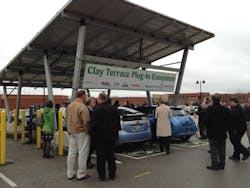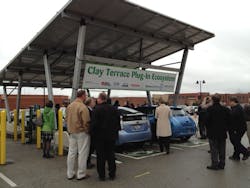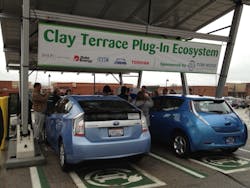And that’s where an interesting “plug-in ecosystem” designed by Energy Systems Network (ESN) comes into play.
ESN launched its charging infrastructure deployment initiative – dubbed “Project Plug-IN” – back in 2009 to find cities willing to help foster the development of EV recharging stations at easy-to-find public locales, such as grocery stores.
Yet ESN’s recharging station design goes a step further than most you might have heard about or seen, as it combines solar panels and wind turbines with a battery storage system to help alleviate – if not eliminate entirely – extra demand from being placed on existing electric grids.
[The video below shows you how all of this – including EV “ride sharing” – is supposed to come together.]
ESN – along with partners Simon Property Group, Toshiba Corp., Duke Energy, ITOCHU Corp., Tom Wood Automotive Group– just opened one of these new solar panel-equipped recharging stations at Clay Terrace in Carmel, IN.
Again, this “plug-in ecosystem” contains both traditional and “quick charge” recharging points that are connected to a 10-kilowatt roof-mounted solar panel, with energy gleaned from those panels stored in Toshiba 75-kilowatt lithium ion batteries.“We combined existing micro-EMS [energy management system] optimization control capabilities with our latest rechargeable battery technology to ensure the efficient management of load within the EV charging system,” said Ryuji Maruyama, general manager of Toshiba’s “Smart Community” division, noting that it is also directly connected to the Duke Energy electrical grid.
For Duke Energy, the installation provides a valuable model for how renewable energy can be aligned with advanced storage technologies to provide a practical power source.
“Because renewable energy sources like solar and wind is intermittent and less reliable, incorporating energy storage can make them much more stable,” said Zachary Kuznar, Duke’s senior project manager for emerging technology.
“This system at Clay Terrace allows us to even out the variable solar output, shift energy from off-peak to peak energy usage times and ‘buffer’ the grid from electric vehicle charging, which can use a substantial amount of energy, particularly with DC quick charging,” he added. “Innovations in grid energy storage can have a tremendous impact on the effectiveness of renewable energy usage.”
It’s an interesting concept; one that is now getting a chance to show its stuff in the real world.


